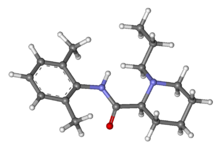Ropivakain
Ropivakain je organsko jedinjenje, koje sadrži 17 atoma ugljenika i ima molekulsku masu od 274,401 Da.[1][2][3][4][5]
 | |
 | |
| Klinički podaci | |
|---|---|
| Drugs.com | Monografija |
| Način primene | Epiduralno |
| Farmakokinetički podaci | |
| Poluvreme eliminacije | 4,2 h |
| Identifikatori | |
| CAS broj | 84057-95-4 |
| ATC kod | N01BB09 (WHO) |
| PubChem | CID 175805 |
| DrugBank | DB00296 |
| ChemSpider | 153165 |
| KEGG | C07532 |
| ChEMBL | CHEMBL1077896 |
| Hemijski podaci | |
| Formula | C17H26N2O |
| Molarna masa | 274,401 |
| |
| |
Osobine уреди
| Osobina | Vrednost |
|---|---|
| Broj akceptora vodonika | 2 |
| Broj donora vodonika | 1 |
| Broj rotacionih veza | 4 |
| Particioni koeficijent[6] (ALogP) | 3,9 |
| Rastvorljivost[7] (logS, log(mol/L)) | -4,1 |
| Polarna površina[8] (PSA, Å2) | 32,3 |
Reference уреди
- ^ Weinberg G, Ripper R, Feinstein DL, Hoffman W: Lipid emulsion infusion rescues dogs from bupivacaine-induced cardiac toxicity. Reg Anesth Pain Med. 2003 May-Jun;28(3):198-202. PMID 12772136
- ^ Picard J, Meek T: Lipid emulsion to treat overdose of local anaesthetic: the gift of the glob. Anaesthesia. 2006 Feb;61(2):107-9. PMID 16430560
- ^ Rosenblatt MA, Abel M, Fischer GW, Itzkovich CJ, Eisenkraft JB: Successful use of a 20% lipid emulsion to resuscitate a patient after a presumed bupivacaine-related cardiac arrest. Anesthesiology. 2006 Jul;105(1):217-8. PMID 16810015
- ^ Knox C, Law V, Jewison T, Liu P, Ly S, Frolkis A, Pon A, Banco K, Mak C, Neveu V, Djoumbou Y, Eisner R, Guo AC, Wishart DS (2011). „DrugBank 3.0: a comprehensive resource for omics research on drugs”. Nucleic Acids Res. 39 (Database issue): D1035—41. PMC 3013709 . PMID 21059682. doi:10.1093/nar/gkq1126.
- ^ David S. Wishart; Craig Knox; An Chi Guo; Dean Cheng; Savita Shrivastava; Dan Tzur; Bijaya Gautam; Murtaza Hassanali (2008). „DrugBank: a knowledgebase for drugs, drug actions and drug targets”. Nucleic acids research. 36 (Database issue): D901—6. PMC 2238889 . PMID 18048412. doi:10.1093/nar/gkm958.
- ^ Ghose, A.K.; Viswanadhan V.N. & Wendoloski, J.J. (1998). „Prediction of Hydrophobic (Lipophilic) Properties of Small Organic Molecules Using Fragment Methods: An Analysis of AlogP and CLogP Methods”. J. Phys. Chem. A. 102: 3762—3772. doi:10.1021/jp980230o.
- ^ Tetko IV, Tanchuk VY, Kasheva TN, Villa AE (2001). „Estimation of Aqueous Solubility of Chemical Compounds Using E-State Indices”. Chem Inf. Comput. Sci. 41: 1488—1493. PMID 11749573. doi:10.1021/ci000392t.
- ^ Ertl P.; Rohde B.; Selzer P. (2000). „Fast calculation of molecular polar surface area as a sum of fragment based contributions and its application to the prediction of drug transport properties”. J. Med. Chem. 43: 3714—3717. PMID 11020286. doi:10.1021/jm000942e.
Literatura уреди
- Hardman JG, Limbird LE, Gilman AG (2001). Goodman & Gilman's The Pharmacological Basis of Therapeutics (10. изд.). New York: McGraw-Hill. ISBN 0071354697. doi:10.1036/0071422803.
- Thomas L. Lemke; David A. Williams, ур. (2007). Foye's Principles of Medicinal Chemistry (6. изд.). Baltimore: Lippincott Willams & Wilkins. ISBN 0781768799.
Spoljašnje veze уреди
| Molimo Vas, obratite pažnju na važno upozorenje u vezi sa temama iz oblasti medicine (zdravlja). |